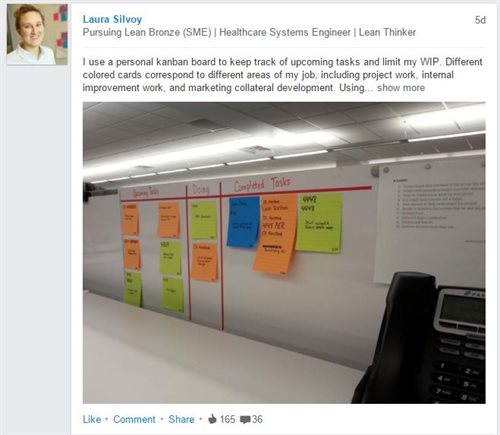About a year ago, I shared an image of my personal kanban board on LinkedIn. This innocent update resulted in a surprising number of comments, likes and profile views. At the time, I couldn’t figure out why that update struck a chord with my connections and followers. It was a simple photo showing a whiteboard with tasks written on vibrant sticky notes.

 Today, I still receive requests from folks interested in learning more about how I use kanban to manage my work. As I speak with more people, I am beginning to understand that task management is a universal problem that we all approach in diverse ways. In fact, each individual might approach it in a variety of ways until they determine the best method.
Today, I still receive requests from folks interested in learning more about how I use kanban to manage my work. As I speak with more people, I am beginning to understand that task management is a universal problem that we all approach in diverse ways. In fact, each individual might approach it in a variety of ways until they determine the best method.
The most common approach to manage tasks that I see is making lists. Do a quick search online. There are millions of articles about why people enjoy making lists; some dating back more than 10 years! This LinkedIn article provides the top 10 reasons for creating lists to share content.
However, I have a big problem with lists. When you apply them to task management, lists can go on for pages, at which point they become overwhelming, leading to frustration and abandonment. At one point, I also used lists to manage tasks, but I would approach them in a different way. Rather than creating a list of tasks to work through and starting at the top, I created my list and selected a few things that I knew I could accomplish in a given time. Those few things are the only items I focused on until I completed them.
I strongly believe that the principles of Personal Kanban Jim Benson teaches are the key to successful task management. The first, limit work in process, helps us focus only on the tasks we’re currently working on. It helps us avoid switch-tasking, which impedes progress, causes us to lose focus and leads to wasted time spent re-focusing on a task. Visualize the work, Jim’s second principle, gives us the ability to truly understand the extent of our assigned tasks.
Looking back on how I approach my task list, I realize that I used those two principles to help me keep work moving forward. This technique allowed me to focus on specific items until I completed them, and then move on to the next set of tasks. This mantra of “focus, finish; focus, finish” is exactly what Jim Benson teaches in his Introduction to Personal Kanban video.
There are many techniques for applying personal kanban as a task-management strategy. As long as you’re following the two basic principles, you can make up the rest of the rules as you go! I previously wrote about my approach to manage tasks and the different methods I used over the past two years. Recently, I converted my white board back to a digital medium. Next time, I’ll describe how I made this transition and the task management techniques that are working best for me at this moment.

